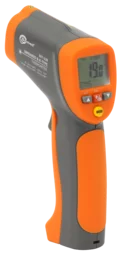Description
Easy way to quick and accurate temperature measurements
Professional and compact infrared (IR) thermometers are a solution
for problems in every area where specific thermal conditions are
required.
The intuitive one-hand operation of the devices and the
ergonomically designed gun-type housing allow for trouble-free daily
work.
Product features
- precise non-contact temperature
measurement
- type K temperature measurement
- ergonomic gun-type housing
- resolution 0.1°F (0.1°C)
- emissivity digitally adjustable from 0.10 to
1.00
- °C/°F switch
- automatic range selection
- high and low alarm
- DATA HOLD function for holding measured
values
- temperature display maximum, minimum, average
and difference
- trigger lock
- AUTO-OFF function
- backlit LCD
Special features
- data memory (LOG) for 20 measurements
- Hi and Lo alarms for signalling exceeding the
set limits of the measuring range
- a specially designed holster for storing the
equipment with the possibility of attaching it to the belt
in standard
- backlit display for easy readings even in
dark areas
Infrared measurements
Temperature meters operating in the infrared are used to determine
the temperature of the surface of the item. The optical system of
the device
detects the emitted, reflected and sent energy, which is collected
and concentrated on the detector. Electronic system converts optical
data into
temperature value. In order to increase precision of the measurement
the laser pointer is built in the device.
Infrared radiation
It is electromagnetic radiation whose wavelength is in the range of
780 nm - 1 mm. It is emitted by any material whose temperature is
greater than 0 K.
Is caused by the movement of electrons inside the atoms of a given
material. Infrared radiation emission increases with increasing
temperature,
where the wavelength is decreasing.
Emissivity
It is a parameter that determines the ability of a material to
radiate heat. It takes values in the range 0 to 1, where the value
of 1
corresponds to the emissivity of the black body and value 0 is the
emissivity of the white body. Each material has its own emissivity
coefficient depending on the type of material, surface roughness,
direction of observation, wavelength and temperature.
D:S ratio
D:S (distance to spot) ratio is the size of the area being evaluated
by the IR thermometer as it relates to distance. In other words,
the area being measured becomes larger as the distance increases.
The smaller the target, the closer you should be to it. This ratio
will have a
significant impact on the accuracy or precision of the reading.


